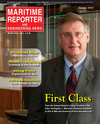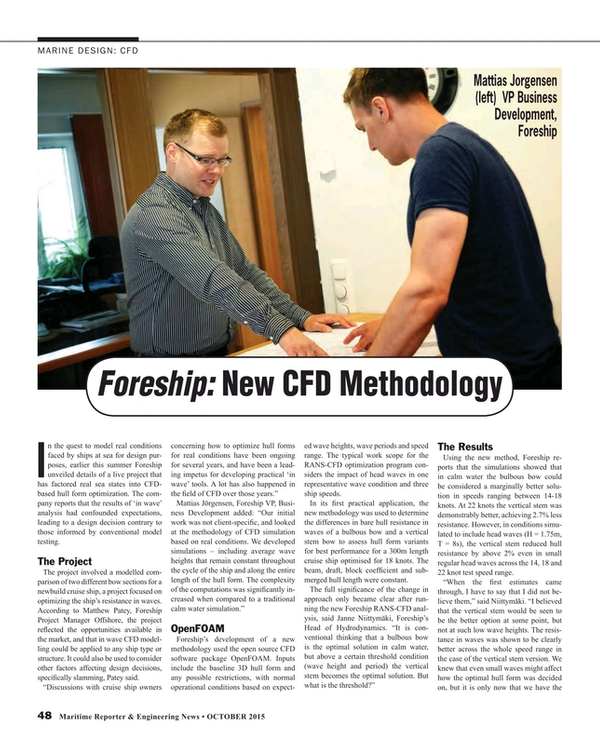
Foreship: New CFD Methodology
In the quest to model real conditions faced by ships at sea for design purposes, earlier this summer Foreship unveiled details of a live project that has factored real sea states into CFD-based hull form optimization. The company reports that the results of ‘in wave’ analysis had confounded expectations, leading to a design decision contrary to those informed by conventional model testing.
The Project
The project involved a modelled comparison of two different bow sections for a newbuild cruise ship, a project focused on optimizing the ship’s resistance in waves. According to Matthew Patey, Foreship Project Manager Offshore, the project reflected the opportunities available in the market, and that in wave CFD modelling could be applied to any ship type or structure. It could also be used to consider other factors affecting design decisions, specifically slamming, Patey said.
“Discussions with cruise ship owners concerning how to optimize hull forms for real conditions have been ongoing for several years, and have been a leading impetus for developing practical ‘in wave’ tools. A lot has also happened in the field of CFD over those years.”
Mattias Jörgensen, Foreship VP, Business Development added: “Our initial work was not client-specific, and looked at the methodology of CFD simulation based on real conditions. We developed simulations – including average wave heights that remain constant throughout the cycle of the ship and along the entire length of the hull form. The complexity of the computations was significantly increased when compared to a traditional calm water simulation.”
OpenFOAM
Foreship’s development of a new methodology used the open source CFD software package OpenFOAM. Inputs include the baseline 3D hull form and any possible restrictions, with normal operational conditions based on expected wave heights, wave periods and speed range. The typical work scope for the RANS-CFD optimization program considers the impact of head waves in one representative wave condition and three ship speeds.
In its first practical application, the new methodology was used to determine the differences in bare hull resistance in waves of a bulbous bow and a vertical stem bow to assess hull form variants for best performance for a 300m length cruise ship optimised for 18 knots. The beam, draft, block coefficient and submerged hull length were constant.
The full significance of the change in approach only became clear after running the new Foreship RANS-CFD analysis, said Janne Niittymäki, Foreship’s Head of Hydrodynamics. “It is conventional thinking that a bulbous bow is the optimal solution in calm water, but above a certain threshold condition (wave height and period) the vertical stem becomes the optimal solution. But what is the threshold?”
The Results
Using the new method, Foreship reports that the simulations showed that in calm water the bulbous bow could be considered a marginally better solution in speeds ranging between 14-18 knots. At 22 knots the vertical stem was demonstrably better, achieving 2.7 percent less resistance. However, in conditions simulated to include head waves (H = 1.75m, T = 8s), the vertical stem reduced hull resistance by above 2 percent even in small regular head waves across the 14, 18 and 22 knot test speed range.
“When the first estimates came through, I have to say that I did not believe them,” said Niittymäki. “I believed that the vertical stem would be seen to be the better option at some point, but not at such low wave heights. The resistance in waves was shown to be clearly better across the whole speed range in the case of the vertical stem version. We knew that even small waves might affect how the optimal hull form was decided on, but it is only now that we have the new methodology that we can measure precisely what the effect will be.”
A 2 percent margin of improvement in terms of frictional resistance is a big deal.
“Naturally, this would not be so significant for other vessel types, but the point is that the methodology is in place to simulate other factors, such as seakeeping or slamming, which may be the leading consideration for other owners,” said Niittymäki.
“Used at an early stage, CFD based on real sea states will improve design decisions on resistance in waves to optimize an entire hull form, but also save the time it takes to wait for a model basin and the cost of model testing,” said Patey. “In addition, CFD simulation is repeatable in a way that model testing is not, meaning that small adjustments can be easily modelled. The simulation can be run quite quickly; part of the development plan for this methodology was that it would need to be commercially applicable.”
Feeding real sea state data into Finite Element Method software could be used as a design tool to address slamming and structural design issues in both the passenger ship and offshore context, said Patey. Modelling using real sea state inputs could also be valuable when it comes to evaluating vibrations, and the same methodology may be adaptable to emulate the extreme waves experienced on rigs.
For the moment, however, Jörgensen believes attention should focus on what has already been achieved. “It was truly a surprise to our hydrodynamics specialists how close to calm seas conditions the vertical stem bow becomes preferable to the bulbous bow,” he said. “This new approach to CFD opens up significant new potential for commercial ship design.”
(As published in the October 2015 edition of Maritime Reporter & Engineering News - http://magazines.marinelink.com/Magazines/MaritimeReporter)
Read Foreship: New CFD Methodology in Pdf, Flash or Html5 edition of October 2015 Maritime Reporter
Other stories from October 2015 issue
Content
- Making Sense and Taking Risks: Human Behavior in the Shipping Industry page: 14
- Ergonomics@Sea page: 16
- The Cost-conscious Manager page: 20
- Black Market Refrigerants Pose Risk to Shippers page: 22
- Marine Firefighting at Sea: Training to Survive page: 28
- Unmanned Vessels: The Future is Now page: 34
- Foreship: New CFD Methodology page: 48
- SCANIA Expands its Engine Range for Marine Applications page: 50
- Towboat Honors Structural Engineer Dobson page: 54
- Ulstein’s X-BOW Turns 10 page: 55
- KVH Debuts mini-VSAT Broadband 2.0 page: 56
- BMT Fluid Mechanics to Validate FLNG Design page: 60
- Hard Problems Demand Soft(ware) Solutions page: 62


